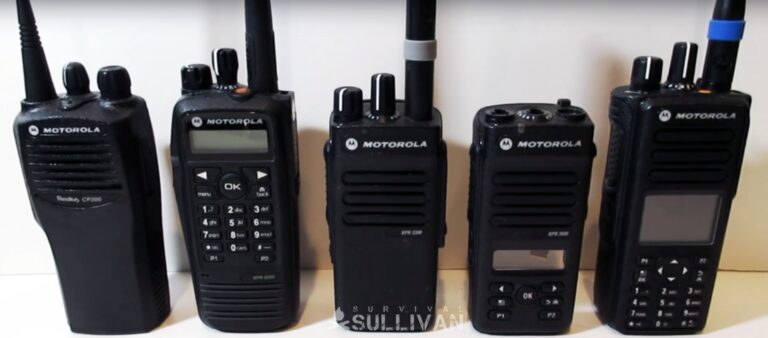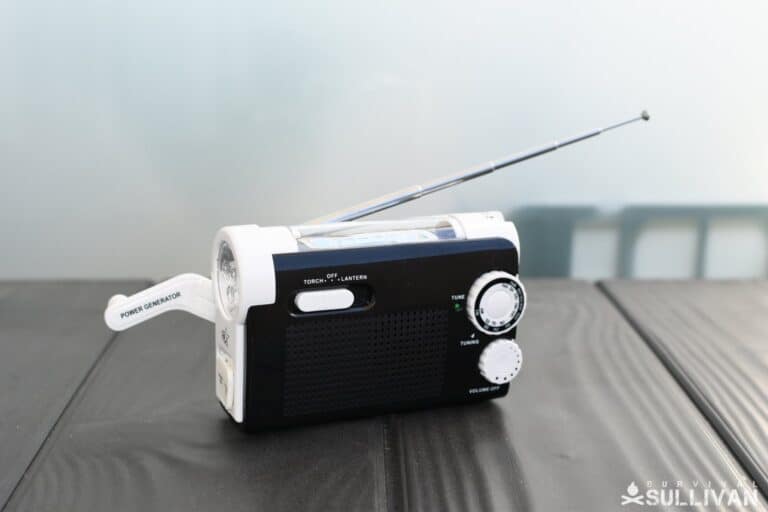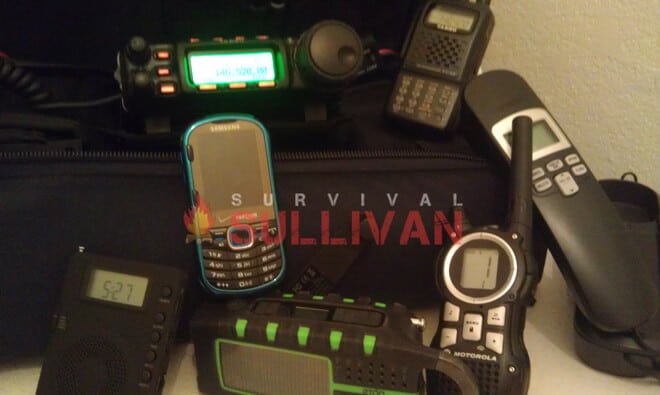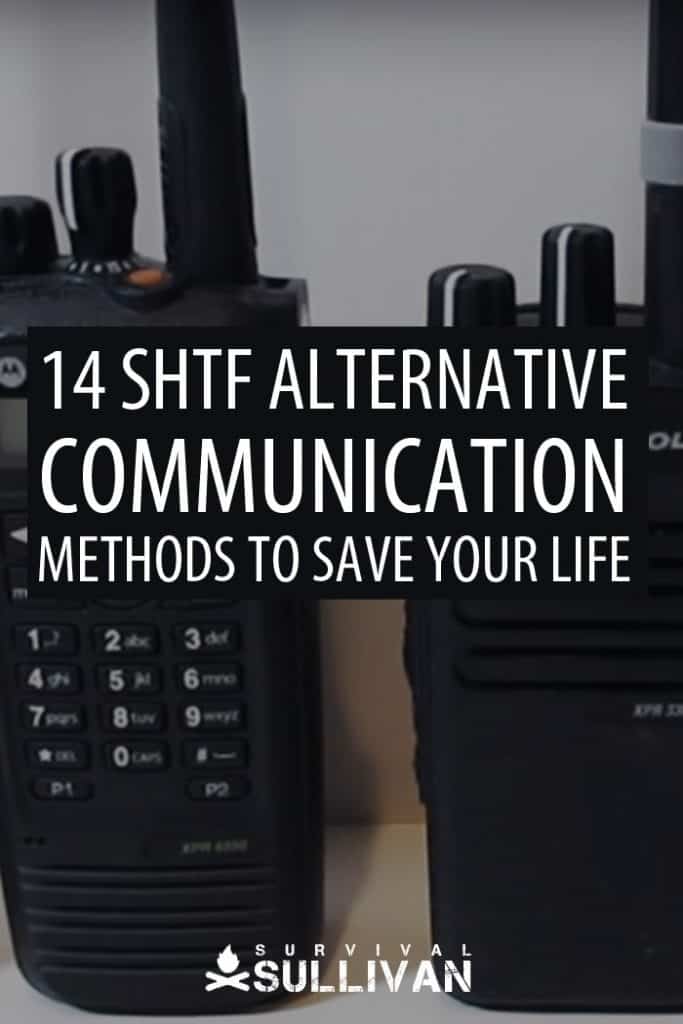In the event of an emergency we want to relay information – about who is with us, who is missing, find out where family members are, arrange meeting points, and reassure loved ones who are far away.

We also need to find out what is happening – how far the flooding, fires, or riots have reached; whether we need to move; which way to go, where shelter is available; and where to find help in case of medical and other emergencies.
This means listening to news broadcasts, contacting people locally, and perhaps even international communication, so you may need a range of communication devices.
You will find that there are numerous ways to accomplish these things, but you have to plan ahead so you are not left desperately trying to establish comms, or making tactical mistakes when trying to reunite your group, or lead them out of danger.
Besides cell phones there are various other tech options as well as the more simplified means of communication that have been used for millennia.
Make sure you know how to use the more “primitive” methods – just in case tech drops you.
14 Ways to Talk to Loved Ones in a Disaster
#1. Cell phones
History has shown us that cell phones are not fully reliable in disasters. During hurricane Katrina, only 70% of calls made it through and during the 9/11 disaster the towers were inundated with calls and this shut down communications.
Flooding during hurricane Sandy created major issues as well. Immediately after a disaster you should still be able to use your cell phone before the networks get jammed.
The best thing is to pre-arrange with all the people near and far that you may need to contact, that you will use instant messages as these will get through when phone calls may not.
As long as the cell tower is working it can relay huge numbers of instant messages even though it may not manage to handle voice calls due to volume.
Unfortunately, cell phones can’t be totally relied on as high winds and flooding can take out power lines and take down the towers. Cell phones also need access to satellites which can be rendered ineffective by hackers, debris, or solar storms.
Make it a habit to always keep your cell phone charged, so in the event of a power outage you have a day’s use. If you have access to a car you can charge your cell phone there.
Disclosure: This post has links to 3rd party websites, so I may get a commission if you buy through those links. Survival Sullivan is a participant in the Amazon Services LLC Associates Program. As an Amazon Associate, I earn from qualifying purchases. See my full disclosure for more.
It’s always good to have one piece of equipment that is multi-functional and this solar powered, wind up, hand-crank emergency radio also has a flashlight, cell phone charger and a reading lamp.
So, if the power goes, and you have no car, at least you have somewhere to charge your cell phone to keep in touch with what is happening.
#2. GoTenna
A fairly new service called goTenna, a Brooklyn based start-up that develops technologies for off-grid communication, allows your cell phone to keep working if towers go down. GoTenna will pair with an Android or iOS device using Bluetooth.
The low band width of 151-154 MHz radio means only text messages can be sent – but that is pretty much all you need in SHTF situations.
By pairing your phone to the goTenna Mesh means you can use your cell phone to share texts and GPS locations privately between goTenna devices. There is a however a drawback – the range is currently only around 4 miles.
#3. Landlines
You still may be able to use conventional technology in these scenarios. Do not assume that all standard communication is down. For instance, always keep a hard wire to plug your computer into your modem.
You will lose Wi-Fi if your power goes out, but you may still be able to tap into the internet with your laptop.
Landlines do not require power and have been a reliable means of communication for 80 years. Check sites to find the closest pay phone to your location. Yes, they still exist and are reliable without power.
Let us assume that these methods of communication are out of the question. You now have a few modern options and a few primitive options. There are a variety of different radios that can help you communicate around the corner or around the world.
There are also more simplified means of communication that have been used for millennia. When in doubt, go back to methods used before modern technology existed.
#4. Walkie-talkies
Walkie-talkies are about as simple as it gets. These hand-held devices allow two-way communication over a short distance.
The distances usually nominated on the packaging is over flat ground – it is best to test walkies talkies first before committing to a purchase to make sure they will perform adequately for your requirements.
Normally, these work for about a two to three mile radius, but can be adversely affected by mountainous or very bushy terrain or blocked by buildings.
Regardless of the distance they provide, do not plan on any privacy. There are only a limited number of two-way channels available in your area.
If anybody else is on the same one, they will be listening to every word you say.
When your plan includes using walkie talkies then perhaps work out a code beforehand to keep locations, food supplies, number in your group, and other sensitive information, secret.
#5. CB radios
Having been part of the trucking industry, I would be remiss if I did not endorse CB radios.
CB radios are simple to use and require no license; although, they have a limited range. I find these radios’ range tend to vary between one and ten miles depending on the terrain.
If you are not familiar with the slang used on CB, you may be quite confused, but with some practice you’ll get used to it.
As with any communication system for SHTF situations it is vital to practice the use of your chosen communications system beforehand so you have mastered it instead of rushing out to buy a communication system once SHTF, when you have no time to learn how to use it properly.
Effective and quick communication can mean the difference between life and death. The CB radio could be a good option if you have somebody living within a few miles of you that knows to meet on a specific channel.
#6. Sat-phones
Satellite phones are a great option, but can be quite expensive. These phones bypass towers and give you a direct connection to the satellite; nevertheless, they require a line of sight.
That means they do not work indoors or in the woods or jungle with heavy overhead cover. The monthly fees are pricey as well.
You may want to consider renting one on your next adventure just to see how well it works and if you have any issues, before going out and buying a sat phone for emergencies.
A good feature of a quality sat phone, like the Garmin InReach Explorer, is that 2-way text Messaging from anywhere is possible with the 100% global iridium satellite coverage.
You can also send an interactive SOS to the 24/7 search and rescue monitoring center, as well as track and share your location with family and friends.
#7. Personal Locator Beacon
If all you need to do is transmit a signal, a PLB may be the best option. Personal locator beacons are devices that use a direct connection to a satellite to send a distress signal. Some are only tied to local authorities, and some allow you to connect to cell customers as well.
However, if there is a large scale disaster, cell service may be down and the local authorities may be out of commission. I like these for off grid hunting trips, but not as much for SHTF scenarios.
#8. Short wave radios
Short wave radios are a very good option for a disaster. They are for receiving only, but are great for weather updates. You can buy hand crank options that require no power source, such as this one:

Short wave can also receive a signal from around the world. Be cautious about your sources though, many of these frequencies are news organizations that can twist the information they broadcast. Take it with a grain of salt.
#9. Miscellaneous radios
There are a few other radio types to consider. Family Radio Service and Multi-Use Radio Service options are simple, but have a lot of the same limitations as CB radios. General Mobile Radio Service devices are much more powerful and cover a larger radius, but require a license.
Scanners are great for listening to local police activity in your area along with Ham, aviation, military, federal, and EMT.
However, they are pretty expensive and can be difficult to program. With some of this equipment, your choice will need to be based on your personal needs.

#10. Ham Radio
That brings us to Ham radio, the ultimate survivalist choice. Ham is simply amateur radio and can be as simple or as complex as you like. It can reach around the block or around the world.
You can use a small handheld device in your bug-out bag, or have a large in home setup. For some people HAM is a lifestyle, and there is a very strong HAM community if you want to learn more.
One of the most wonderful things about HAM is that you can build one with spare parts lying around your home. If we were to have an EMP blast, this would be crucial.
In WWII, there were soldiers that made foxhole radios to receive signals with items as simple as a pencil and razor blade.
You can also make a spark gap AM transmitter with household items to transmit a Morse code signal over very long distances. Be careful not to get electrocuted with this one.
Now there is no problem with making a transmitter but as to actually using it, by connecting the antenna and transmitting, requires a license.
Ham was the only consistent way that people were able to communicate during hurricane Katrina. It does require a license to operate a Ham radio, but they are easy to get.
There are three levels: technician, general, and extra. To use equipment that travels over longer distances, you would need to upgrade your license.
Repeaters allow your signal to be shot out over much larger distances. You can even use the internet for a remote transmission, so your signal can originate from any point in the world you wish.
You would likely need to upgrade your antenna for longer distances. Your transmission radius is greatly affected by the quality of the antenna.
The Federal Communications Commission (FCC) has strict rules as to what radios may be used and one should be wary of imports that do not comply with the requirements. To find out more, read this article.
Trump’s signing of the January 24, 2020 PIRATE Act (Preventing Illegal Radio Abuse through Enforcement, has resulted in changes. It is best to read up about what is now legal and what is not, here.
One of the reasons that HAM is great for preppers and survivalists is that it’s what the Military Auxiliary Radio Service and the Amateur Radio Emergency Service use. Ham connects to the National Weather Service as well.
If you want to be stealthy with your communication, Ham is the way to go.
It’s hard to monitor because of the volume of users. You can also transmit on one frequency and then receive on another so nobody can ever listen to more than half of your conversation.
Some people disguise their antenna so it is not visible to others. Antennas can be built into flagpoles, fences, ladders, or even placed underground.
12. Scanners and Scanner Apps
Buying a scanner to pick up police signals directly is illegal in some countries but in the US, you should be fine (for now).
This scanner enables a person to listen in to the transmissions of police, emergency, fire, weather and other services enabling you to be informed and make decisions accordingly. You have to make sure the scanner is tuned to the right frequencies for it to be effective.
There are a variety of scanner apps for both Android and iOS systems but seeing as you can’t listen in directly to police and emergency service radio transmissions you are relying on people who do have access, to receive and encode the signals, and then give access via the internet.
#13. Signalling for Rescue
If you want to go primitive, there are plenty of ways to do it. In a search and rescue situation, ground-to-air and ground-to-ground signals are very important.
For stationary signals, contrast is key. Use black rocks or logs against snow to write ‘SOS’ for helicopters to spot.
Blaze your trail as you hike by chopping marks on trees exposing the white underwood against the dark bark. Build a signal fire and dump green material on it for white smoke or rubber/plastic on it for black smoke.
You can also use a signal mirror, laser pointer, tactical flashlight, flare, or whistle to get the attention of rescuers.
#14. Morse Code
In emergency situations, code is very important. People could see you dropping your note and use that information to try and steal supplies. Either use Morse code or come up with a system of your own.
Watch this video to learn how to use it:
… and this is a useful Morse code sheet.
The more you practice the faster you’ll be at sending messages. Kids should know how to use Morse code and be able to send simple messages. They can do it by tapping a pencil or pen, using knocks to communicate, or striking a piece of iron on a rock.
Morse code could be invaluable in guiding rescuers to a spot if someone is trapped under rubble and simply doesn’t have the energy to yell, but can tap out a message to direct rescuers, convey information on others trapped, and injuries, which are all helpful in
Making a Communications Plan
If you need to communicate with family or friends close by, having a plan is key. Make sure your family knows where to meet if SHTF.
You can also set up a note drop system with others in your area. Find an agreed-upon spot and drop a note there.
Come back the next day looking for a response. This can help you coordinate several people over a larger area to pool supplies or manpower.
These are the 3C’s to remember in your plan.
Clarity: Be very clear on where to meet, when, how long to wait, who to contact.
Decide beforehand whether family members should react to an SMS or a phone call (if still possible) or whether they should simply run for the hills to the appointed spot when a certain event happens.
Instructions per telephone can alter – remember the broken telephone’s game where the final message was very different to the initial one. Perhaps have one person designated to contact other family members rather than various people relaying a message.
Of course, if the designated person cannot make contact due to injury or for some other reason then there should be a backup plan. Make sure messages are unambiguous. “Meet at 6,” could be 6 am or 6 pm – rather use military time and make sure the kids know that 18:00 hours is 6 pm.
Make sure everyone has been to the meeting point and knows exactly how to get there either from school/university, home, the office, a friend’s place or wherever they might be in town.
Teach the family the main route and alternate routes so they become second nature and they can find their way there without any problems – remember landmarks may have disappeared in a flood/fire, so they will have to know the area really well.
Complete: Make sure instructions are complete – what time, exactly where – not just the big tree at the corner – Which corner?
Have a message drafted on your cell so all you have to do is press send to the various people you need to contact, just check if there are any changes before you press send though.
The message should have details of who to meet, what to bring, the exact location and time. A preloaded location pin could help too. In an emergency people tend to forget basic things, so if people need to grab their bug out bags this should be mentioned in the message.
Make sure people know whose job it is to save the various family pets. For example, “Rick will get Spot, Megan will get the cat,” – whichever family member has the closest bond to the animal should be the first choice with a backup choice if these chosen family members are not at home.
For cats and very small dogs have a pet carrier ready, larger dogs should have their leashes stored ready to grab. In an emergency pets will be scared too, and you don’t want to risk losing them.
Concise: Messages need to be short, conveying the necessary information without ambiguity using the least number of words. Practice composing messages remembering WWWWH – who, when, where, what, how.
Example: Kaylee meet family at 15:00H at 52 Stanford St, bring your BOB, and get there by bike or walk. (52 Stanford St could be code for a pre-organised destination).
Everyone in the family should learn the NATO phonetic alphabet in case radio communication is not very clear.
This helps make sure the message is not misinterpreted by those hard of hearing or the young. You know the story, “I thought you said tree instead of three.”
Other Primitive Ways to Communicate
You can also come up with visual cues to communicate with those that have a line of sight.
You can devise a flag system or use a tactical flashlight to signal with Morse code.
Agree to head to your roof at a specific time to signal somebody that will also be on their roof at that time.
Also, look for markings on a specific mailbox or tree to communicate a plan with others. Sound can accomplish the same thing.
Use whistle blows or horn blasts to communicate with people close enough to hear. These systems have been used for thousands of years.
If you are in very close proximity, nonverbal communication can still be important. There will be times that you need to tell a group to get down or to advance without alerting a specific threat in the area.
Hand signals are great for this and are commonly used by the military.
If you need to communicate over very long distances, sending a messenger is likely your only option.
Carefully choose whether to send your message verbally or to send a sealed note. If you go verbal, there is room for the messenger to misinterpret the message. If you send a note, it could be intercepted. You may want to rely on code to be safe.
Final Word
When SHTF, communication is very important. Initially it is just used to make sure your family is safe. However, you will quickly find that there is strength in numbers when you are trying to survive.
Whichever method of communication you choose, I suggest you become very familiar with it. Make sure that everybody in your network knows how you will communicate and encourage them to get on board with the same method.


My name is Ryan Dotson and I am a survivalist, prepper, writer, and photographer. I grew up in the Ozark Mountains and in the foothills of the Pocono Mountains. My interest in survival started when I was in Boy Scouts and continued as my father, uncle, and grandfather taught me to hunt and fish. In the last few years I have started taking on survival challenges and have started writing about my experiences. I currently live in Mid-Missouri with my wife Lauren and three year old son Andrew.

You left out one of the best approaches. Send instant messages rather than voice calls if you can’t make a voice call. A short instant message only requires a single block of data and can get through even through there isn’t bandwidth for a voice call. A working cell tower which is unable to make voice calls because of the volume can send huge numbers of instant messages. I understand that this worked during Katrina; that a handful of working cell towers, some running off of battery power, where able to carry IMs during the critical aftermath.
If you don’t know Morse code, another code which is very simple is Tap code, also known as A F L Q V code. Google it! It only takes a minute or two to learn it!
Just about any radio, can be listened to , with either a scanner or another radio for the same service, unless the radio is using encryption or a digital mode unknown or unable to be decoded by the listener.
Always assume others are listening in a shtf situation and communicate accordingly